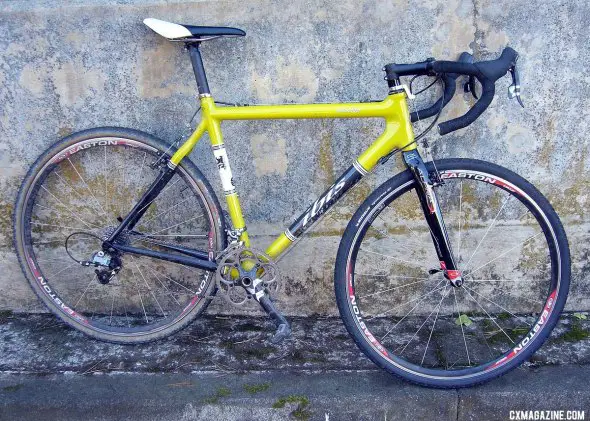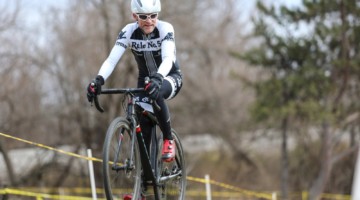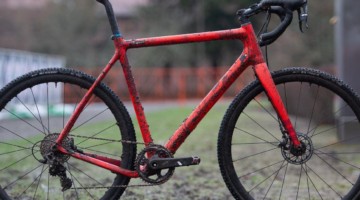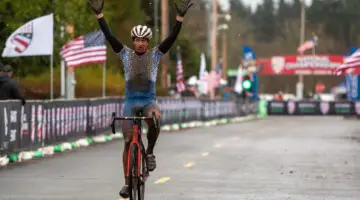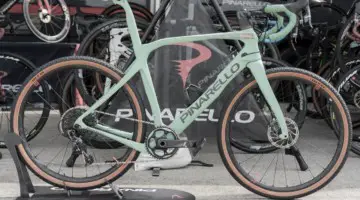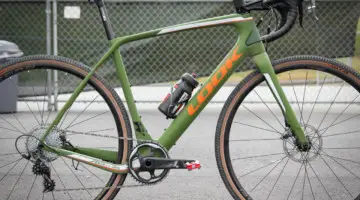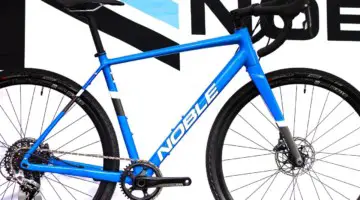The Ibis Hakkalugi cyclocross bike disappeared, went on a crash diet, got a new wardrobe, but is still waiting for your next cyclocross adventure.
Testers: Andrew Yee & Clifford Lee
Words: Andrew Yee, Photos: Clifford Lee
Originally published in Issue 8 in 2010, available in digital form instantly on uberflip.
I distinctly remember an old cycling magazine when I was a little kid that featured some early hand-built mountain bikes. The two that caught my eye, mostly because of their intricate paint jobs, were a black and white Fat Chance and swirly, candy-colored Ibis. I didn’t really know anything about materials or geometry at the time—heck, I wouldn’t even own my first mountain bike until four years later, but the artistry of the bike, combined with the fact that I desperately wanted a mountain bike, had a lasting impact on me. Fat Chance has long since disappeared, but Ibis is going strong after an ownership change, bankruptcy and reemergence in 2005.
Ibis released its first cyclocross bike, the Hakkalugi in 1997 with its trademark “handjob” cable hanger, and that hand-built frame also became an object of my lust. And so when I got wind of Ibis’ comeback (well before this magazine started), the first thing I did is fire off an email to Ibis founder Scott Nicol to inquire about the Hakkalugi’s return. To my disappointment, I got back a response that said they’ll focus on mountain and road, and thus my unsatiated desire would continue.
Well, 25 years after that first drool session and it finally happened—I got to ride a brand new Ibis. Ibis heard enough demands for a ’cross bike, and one arrived at our headquarters. Even if it didn’t come with the perks of ownership, would my quarter-century wait be worth it?
The Frame
Ibis’ return shocked many traditionalists with their switch from handmade steel and titanium bicycles to carbon. Nicol isn’t wedded (or welded?) to a material and embraces new technology, provided it allows for the ride he’s trying to achieve. The new Hakkalugi is constructed from Toray T700 intermediate modulus fiber—not the same high modulus fiber used in the company’s road bike. This isn’t for cost savings but rather for greater strength and toughness, according to Nicol. As a result, the frame is just over 100 grams heavier than the road model, at 1150 grams for a 53cm frame—still an impressive weight.
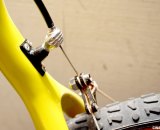
The Ibis Hakkalugi handjob cable hanger shows this is not just any other carbon cyclocross bike. © Cyclocross Magazine
Ibis shows its mountain bike heritage in the frame’s geometry, with a slightly sloping top tube, bottom bracket a bit on the higher side (6.2cm drop) and slacker angles (71.5 head angle, 72 degree seat angle on our 55cm test bike). Head tubes are generously long at 16cm, allowing plenty of room for your shoulder and a higher handlebar height. Effective top tube length is 55.9cm. Shift cables are routed along the down tube, and there are dual bottle mounts for your longer adventures.
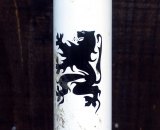
The small touches give the Ibis Hakkalugi character: The lion of Flanders coughing up some phlegm. © Cyclocross Magazine
The two standout features of the bike have got to be the handjob rear cable hanger and “Phlegmish” paintjob. In April at Sea Otter, Nicol said they were still perfecting the handjob, and while I can’t tell the difference between the one I saw then and the one on our test bike, it certainly adds a unique Ibis flair and, without exception, is always the first thing onlookers comment on. Careful observers will notice that even the Flemish lion has got a phlegm problem and, in honor of the bike’s name, is hocking a lugi.
The Build
The $3299 complete bikes come with a Alpha Q CX20 carbon cyclocross fork [Ed. note: 2011 bikes now come with an ENVE carbon cyclocross fork], a Cane Creek “Hiddenset” and the option for either a Shimano 6700 Ultegra or SRAM Force kit. Our test bike came with the Force kit and featured TRP EuroX alloy cantilevers (with toe-in adjustable pads), Easton Circuit clincher wheels, Michelin Jet tires and a San Marco Zoncolan saddle. Ibis’ own bar, stem and seatpost round out the package. Gearing mates a 12-27 SRAM Force cassette with a carbon Force crankset with compact 50/34 chainrings for a wide range of gearing. At first glance, the chainring choice was the only suspect component choice for such a high-end ’cross bike. We’re more forgiving of this option on an entry-level, multi-purpose bike, but for ’cross racing, the large jump between rings can be problematic. [Update: Ibis offers the Hakkalugi complete bike with two build options in 2012, with 36/46 and 38/46 chainring combinations]
The Ride
Despite a brief stay in Bozeman, Montana, Ibis Cycles is a thoroughbred Northern California company, and it’s clear the terrain and long history of NorCal cyclocross has had an influence on the design of the Hakkalugi. I took the Hakkalugi out for an urban ’cross race in San Francisco that featured long climbs, rutted trails and a long fire road descent paired with a short, switchback-filled singletrack section. The first few laps of a ’cross course on the Hakkalugi tell a distinct picture—the bike is stable and smooth, and it excels through the bumps, long fire road sections and gnarly “jungle cross” the region used to be famous for. It’s stiff but certainly nowhere close to harsh, and riding to ’cross practice with the tires pumped up is when you really notice the vibration absorption abilities of the frame.
Bombing down trails was a joy. The taller head tube and relaxed head angle made it easy to just relax and let it roll. The stout CX20 fork certainly helped in this area as well. It did a good job of resisting fork shudder even when I slammed on the brakes as I got deeper into the jungle. It’s the kind of ride that makes you want to duck under the course tape to escape the convoluted route of a ’cross course and just ride whatever the trail presents.
On switchbacks and in grass crits, the bike felt a little sluggish, and getting around hairpins took a little more effort and muscle than I’m used to. This was likely due to the combination of the taller head tube and moderate bottom bracket height. A lower handlebar position to offset the taller head tube may have helped a bit and reduced my center of gravity, but in reality, how much of your riding is really spent navigating such features? Except for the few sharp turns during a race, a very small section of the course, I was perfectly comfortable on the bike.
Got a run-up? No problem. The bike sits comfortably on your shoulder with its broad, flattened underside of the top tube, and because, quite simply, the bike is light. Throw on a set of lightweight race wheels and you’ve really got a weight weenie’s dream.
Our only real complaints have to do with the bike as built. The parts spec is excellent. The shifters were precise, the Ibis branded components were reasonably light and durable and the wheels held true. But while the 50/34 chainrings are appropriate for the go-anywhere nature of the Hakkalugi’s ride, they proved to be problematic in real races, as the sweet spot gear combinations were near the small/small or big/big combinations. The lack of a front shifter small ring trim really exacerbates this problem with an audible reminder that something is amiss—chain rub is an issue despite SRAM’s claims a trim isn’t needed.
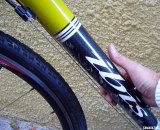
One sticking point: The gap between the shift cables and the downtube can catch your fingers. © Cyclocross Magazine
The bike features down tube cable routing. We actually don’t mind down tube cable routing at all, especially with Gore’s Sealed cable system, but the down tube cable housing stops on the Hakkalugi are offset quite far from the down tube. This creates a sizable gap that allows you to stick your fingers underneath the shift cable by mistake or get your glove get caught on the cable. With some practice, you’ll learn to avoid both with a careful grip when shouldering the bike, but whether you’ll remember to do the same while seeing red and trying your best to keep that last bacon hand-up down remains to be seen.
A smaller complaint would be the choice of the Michelin Jet tires. They’re certainly fast and great “mixed terrain” tires, but the more aggressive Mud 2 may provide more versatility on the average ’cross course. And for some reason, the San Marco Zoncolan saddle didn’t agree with me—the problem wasn’t my derrière’s shape, but sadly, my weight. An imperfect mount with my 160 pounds crumpled the seat rails, ending my ride. Perhaps I shouldn’t be surprised. I’ve seen the type of riders who win on the Zoncolan climb in the Giro, and I don’t look anything like them.
Mud clearance is pretty good, and sizing runs pretty middle of the road. It’s worth noting that the frames have small but unusual variances in geometry from size to size. We’ve seen other companies keep a consistent bottom bracket height throughout all sizes, while others get higher bottom brackets in bigger sizes (for longer cranks), and a few bikes (like the carbon Stevens we reviewed in Issue 6) went the opposite direction with the highest bottom bracket for smaller bikes. Oddly, the Hakkalugi does it both ways. The two highest bottom brackets are found on its largest and smallest sizes (5.6cm drop on the 61cm, and 6.0cm on the 47cm, compared to our 6.2cm drop on a 55cm frame). Head tube and seat tube angles among different sizes vary slightly, which is normal, but the changes between sizes are a little unpredictable. There’s a good reason for this, as Ibis founder Nicol explains that the top tube, head tube and down tube all come from the same molds as the company’s Silk road model. Nicol said the choice kept the price down and made the project affordable. “It’s unlikely that we would have gotten this project off the ground as soon as we did, these molds are extremely expensive to design and produce,” Nicol says. The net result? We’re not really sure how the other sizes handle without having ridden them (although the tall 2010 45-49 Cyclocross National Champion Don Myrah and petite former Masters 30-34 Cyclocross National Champion Barb Howe seem to be doing just fine on their frames).
The Verdict
The Hakkalugi is the perfect example of bike evolution. It’s gotten faster and lighter, and yet remained true to its roots and proudly displays its heritage. It’s a great cyclocross bike in the classic spirit of cyclocross: getting you and your bike from point A to B regardless of terrain. It’s not the most aggressive, racy bike, but does well in races just the same.
But as much as I try hard to keep the emotional, superfluous fluff out of a review, I’d be lying if the bike’s aesthetics and my childhood lust for the brand didn’t have at least some role in my enjoyment of riding the bike. The handjob cable hanger combined with the unique, eye-catching paint creates a conversation-starting bike and brings tons of compliments. Even while I was waiting at a traffic light, two road cyclists pulled over to compliment me about the bike. My honest reply? I was sad I had to give it back.
Psyched:
- Racers who think racing is just one aspect of riding a ’cross bike
- Belief in Ibis’ new philosophy that “steel is real…heavy”
- Cyclists who think handjobs are an art form better suited to bikes than massages
Bummed:
- Grass crit specialists
- Those scared to buy or install chainrings
- Anyone grossed out by phlegm and handjobs
The Specs:
Bike: Ibis Hakkalugi
Sizes: 47, 50, 53, 55 (tested), 58, 61cm
Frame: Ibis Toray T700 intermediate modulus fiber
Fork: Alpha Q CX20, carbon steerer
Headset: Cane Creek IS3i (Campy Hiddenset Standard), 1-1/8”
Wheelset: Easton Circuit
Tires: Michelin Jet 700 x 30c folding clinchers
Shifters: SRAM Force
Derailleurs: SRAM Force
Crankset: SRAM Force 50/34T (172.5)
Cassette: SRAM Force 12-27T
Brakes: TRP EuroX Cantilever
Handlebar: Ibis 7075-T6 DB
Stem: Ibis 3D Forged Seatpost: Ibis 3D Forged 7075 31.6 x 250mm
Saddle: San Marco Zoncolan-Titanox rails
Pedals: None
Weight: 17.25lbs (without pedals), 10.5lbs without wheels
MSRP: $3299
Country of Origin: China
More info: Ibiscycles.com













